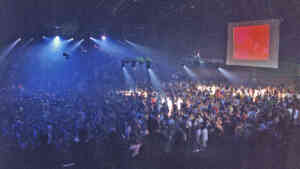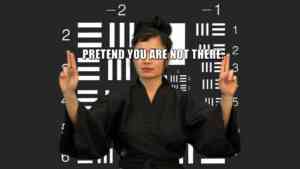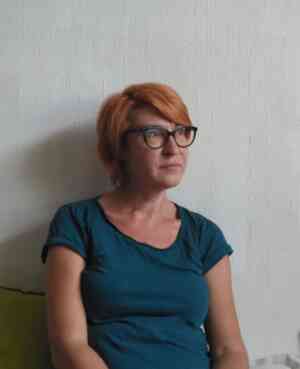On the turbulent years of the digital revolution and the boredom present

"You're lucky to have lived in the 90s when you were discovering all these new things, like electronic music, the internet, contemporary and digital art, etc. Now everything is so boring, our generation is lazy and bored, there's nothing to impress us and excite us like you were excited by the things you discovered in the 90s and the new millennium..."
I begin with this quote from a spontaneous conversation of my colleague Venelin Shurelov with students of National Academy of Theatre and Film Art (NATFA) in Sofia, in front of his public art installation "One Person" in the city center of Sofia.
Inspired by the previous blog posts, I also decided to do a slightly retrospective article, in which I will look at processes and events from my perspective as a curator (from) in Bulgaria, who started to work with digital arts in the late 1990s in a country that until recently belonged to the socialist bloc and thus was experiencing its own turbulent period of transition during those years. As you can guess, these are my youthful years, and so I feel nostalgic and a bit wistful for those wonderful crazy times...
So yes, we were lucky in that respect. Even though things were boiling and seething around us with the constant political and economic crises that accompanied this tumultuous Eastern European transition, we were floating on the wings of youth, intoxicated by the new discoveries in contemporary art and rave culture that had taken over the Bulgarian major cities.
Now, teaching net art in the MFA Digital Arts program at the National Academy of Art in Sofia, I often think back to those times and feel that mix sense of elation and sadness. That I was a part of those great times, but also that we had huge challenges and hurdles that are no longer valid these days (like being able easily to edit a photo and cut a video file and to send them quickly in high resolution). That's why I tell my students that they are actually lucky, because now digital technologies and services are much more advanced and they have to make the most optimal use of these resources and achievements.
But still, I think I understand well the presumption of these young people I quoted above, that these processes cannot be as exciting and revolutionary now as they were in those days when the WWW became accessible and many artists and intellectuals believed that it would be that democratic new medium that would level many of the injustices of the world and give people a chance to communicate freely....
Feminism and cyberfeminism, which many of my colleagues write about on this blog, is getting a strong boost thanks to this, but I won't dwell on those topics and processes here, because they have never been that central focus to my practice. At the end of 1999, having just graduated in Art History from the National Academy of Art in Sofia, I joined the team of the Interspace Media Arts Centre, the first media arts association in Bulgaria. In this male-dominated collective, including Petko Dourmana, Krassimir Terziev and many others, I was not so tempted by feminist themes and issues. It was not because female artists did not participate in our projects, on the contrary, they had their enviable partake, but let’s say in general feminist themes were not so prominent for our generation in Bulgaria, although they were present in one way or another in our projects and practice.
Here I'd like to focus on a few projects that are among my most inspiring digital female artists from then and now:
I start with the VJ performances of young Bulgarian female artists in the late 90s and early 2000s. The booming party culture in Bulgaria opened a new niche for many emerging artists of that time. The combination of electronic music and visuals mixed live by musicians and visual artists was an incredible thrill and encounter with the audience. This new platform for expression gave a chance to many young artists, among them some women, like Boryana Rossa, Daniela Kostova, and others... For all of us it was one of the most fascinating things that emerged, especially as they acquired a cult halo of magicians who ignited the audience and gave them a unique experience. Often they used ready-made segments from their video art projects, which they mixed live in clubs or outdoors (at that time the outdoor parties on rooftops, parking lots or abandoned buildings were very popular). This was another way for them to present their work in a different context and in this live and vibrant way that reached the audience directly.
Beyond this fascinating party culture, there were of course many other strong appearances of female artists, mainly with video and installation. Here I can mention Boryana Rossa, one of the very active figures of the then emerging art scene in Sofia, now based in the USA. Boryana Rossa's video The Moon and the Sunshine (2000), in which in a very delicate and sensitive way she reveals clichés and stereotypes related to gender and the role of women in a post-socialist society. At the same time, the issue of covert domestic violence, a taboo subject in Bulgarian society for a long time, is also raised.

The opportunity to travel and participate in various forums abroad has exposed me to many intriguing works by international female artists. Among those that impressed me most were the video works of Anetta Mona Chisa and Lucia Tkáčová. Their intellectually - provocative and humorous videos grab the viewer's attention to question topics and issues related to traditions, gender stereotypes and the art market. Such as one of their early videos projects Dialectics of Subjection (2004-06), in which in a casually "feminine" light-hearted way, commenting issues like with whom of the world art scene they would sleep with, and for what money, they question the way women are perceived in general.
My favourite project of theirs though is Try again. Fail again. Fail better. (2011), in which they deploy their critical practice and open up multiple perspectives, such as the symbol system and ideology that uses them. Can the symbols of revolution and protest break free from the ideologies of their previous uses and take a new direction, or does the struggle to steer them remain as chaotic and pointless as holding a balloon full of air on a windy day...?

Another favourite project of mine is How Not to Be Seen by Hito Steyerl. In her typical humorous way, the artist shows in the form of tutorials several ways to disappear or not to be noticed. At the core of her project is a critical study of the production, use and circulation of images from the mid-20th century to the information age. Thousands of constraints and rules that attempt to regulate these activities become a cause for opposition and hence a boost for artistic action. I like the way she refers to the technologies that are gaining mass usage and production, while her critical nature can directly state that AI is more of an artificial stupidity, though she admits it has “already monumental social implications in global politics”.

Speaking of artificial intelligence and algorithmic systems, I'd like to leave an open end to my impromptu selection with the projects of Ai-DA - this interesting persona, described as the “first ultra-realistic robot artist”, created by the gallerist Aidan Meller, in collaboration with Engineered Arts. Her existence and artistic appearance is overwhelmingly impressive and raises a series of issues, such as what should we expect by the future generation of robot artists stepping on the world art scene… However, as the title of one of the forums where Ai-DA had one of her star performances - Ars Electronica’s European ARTificial Intelligence Lab exhibition Out of the Box: The Midlife Crisis of the Digital Revolution" - suggests, we are in the midlife crisis moment and many things are being questioned, much of our initial momentum has been lost and what used to give us wings, we now greet with a weary look...
Finally, if I refer back to the words I began with in this article, what could break the boredom of today's young people daily experience? I think there are many occasions for them to be rebellious and to criticize dominant systems, like the monopolization of the digital world, for example. But to what extent do they care about that and whether they are already totally taken over by their non-stop browsing and stay on social networks, by this fast food consumption of the things there...? Still, I intuitively believe that nothing is lost and that today's youth are the future revolutionaries who will defend our rights against machine learning/deep learning systems, for example. We shall see...
- Image credits:
- Title Image: photo is courtesy of Metropolis © ravearchive.space
- Boryana Rossa, The Moon and the Sunsine video, 2000
- Anetta Mona Chisa and Lucia Tkáčová, Try again. Fail again. Fail better., video, 2011
- Hito Steyerl, How Not to Be Seen: A Fucking Didactic Educational .MOV File, video, 2013


